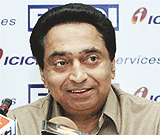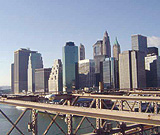|
A
MOTLEY COLLECTION OF BUSINESS AND ECONOMIC NEWS |
|

|
 India on world radar for investments: Kamal Nath India on world radar for investments: Kamal Nath
India’s robust economic growth has put the country on the world radar for attracting investments from global investors, said Commerce and Industry Minister Kamal Nath.
“India is on the world radar as never before, thanks to the current robust economic growth. No investor wants surprises, but (they want) improvements. And that is what we promise to deliver,” the minister told about 750 business delegates from 26 countries participating in the three-day CII partnership summit here. “The time for surprises is over. Now, we shall we give you constant improvement and betterment.”
Asserting there could not have been a better time to engage with India, he said the reforms process was being widened and deepened to provide opportunities to businesses from the world over.
‘The foreign direct investment (FDI) regime is getting progressively liberalised. The regulatory mechanisms are being strengthened and overseas investments in key areas of infrastructure are being made most welcome,’ the minister pointed out.
In this context, Kamal Nath said foreign inflows, including portfolio investment, were estimated to touch about $15 billion by the end of the current fiscal (2006-07), with more overseas firms eyeing good returns from the subcontinent.
While foreign institutional investment (FII) is set to account for $12 billion, the FDI will be about $3 billion. The overall foreign investment, including FII and FDI, is expected to go up by 120 percent over the last fiscal.
|
|
|
 $10 billion SPV planned out of forex kitty $10 billion SPV planned out of forex kitty
The finance ministry is considering a proposal to use part of India ‘s $177-billion forex reserves for infrastructure projects, by floating a special purpose vehicle (SPV) called India Investment Corporation (IIC) with a corpus of $10 billion.
The SPV, which will be formed to fund long-term infrastructure projects, will invest in corporate and infrastructure bonds. Apart from ensuring fund flow to India’s creaking infrastructure, the move is also expected to ensure a better rate of return for RBI, which normally invest India ‘s forex kitty in overseas treasury papers.
The proposed funding option is expected to come as a boost to sectors like power, roads, airports, ports and railways. “If the SPV can provide long-term debt, it will be a major boost to the resource-starved infrastructure projects,” said Feedback Ventures chairman Vinayak Chatterjee. “Although funds from commercial banks are available for the medium term of 4-6 years, there is a real dearth of long-term funds. A road project, for instance, needs loans for 20 years, which is not easily available in the Indian debt market,” he pointed out.
According to a government source, the SPV will have the mandate to follow a moderately aggressive investment strategy, which will include co-financing of ECBs raised by Indian infrastructure companies. The SPV will also seek to provide debt to Indian infrastructure companies at competitive interest rates, in the region of 25 basis points below prevailing market rates.
While the forex reserves are initially targeted to be used in domestic market instruments, later on the corpus of India Investment Corporation could be raised for overseas investments too. The government has estimated a total investment of $350 billion over the next five years in infrastructure. It has been toying with the idea of using its forex reserves to build infrastructure, given the domestic trend in deposits and the lack of long-term funds.
|
|
|
 $10 billion SPV planned out of forex kitty $10 billion SPV planned out of forex kitty
Global business executives are more confident about the economic outlook for their businesses in 2007, led by rising optimism in Asia and Europe. Business sentiment is at an all-time high in India, which tops the list of 32 countries surveyed by London-based accounting firm Grant Thornton.
Business sentiment in Asia is at an all-time high with India the most upbeat, followed by the Philippines and China, according to Grant Thornton International’s new survey on business optimism/pessimism that polled 7,200 leaders of private firms in 32 countries. Asian countries took the top four spots on the list. The indicator covers 81% global GDP.
India was the most upbeat with 97% of the respondents optimistic. The Philippines followed with 88%, China was third at 85% and Singapore fourth with 84%. Ireland, the Netherlands, South Africa, Hong Kong, Sweden and Argentina filled the remaining top 10 spots with the global average at 45%.
The poll, which was included in the firm’s International Business Report (IBR) for 2007, indicated that for the first time in five years, the findings of the survey didn’t appear to be influenced by extraordinary global events like terrorism, natural disasters or health threats.
India’s position at the top of the optimism/pessimism league table has strengthened to an unprecedented +97% up from +93% in 2006.The survey is based on the percentage balance of positive and negative responses. The highest possible figure countries are able to record is 100 and the lowest is minus 100.
“It is remarkable to note the jump in confidence over the Indian economy among Indian business owners to a balance of 97% from 93% in 2006, and therefore for the fourth consecutive year Indian business owners are the most optimistic amongst over 7,000 others in 32 countries globally. It is this business confidence of Indian business owners that is marking the steady stream of global acquisitions by Indian corporates,” Vishesh Chandiok, Partner & Director, International Business, Grant Thornton India said.
|
|
|
 Realty story: FDI skyscraper to grow US$ 10 billion taller in H1 Realty story: FDI skyscraper to grow US$ 10 billion taller in H1
The boom in real estate is being complemented by an ever-increasing influx of funds. While more than 35 big-ticket foreign funds have already checked in, industry watchers are confident that the first half of 2007 will see at least 20 more funds making an India entry.
This would ensure another $10 billion addition to the FDI pie in the real estate sector. Experts say many Malaysian companies are also looking at entering India. According to industry estimates, nearly 90-100 real estate funds have already parked themselves in the country scouting for investment opportunities.
The Philippines-based Ayala, Dubai-based asset management firm Signature group, Och-Ziff Capital, EurIndia and Old Lane are some of the recent additions to the list of funds operating in India. “The India story has evinced interest from eminent global real estate business houses. Though it is difficult to estimate the exact number of investors who could set up India operations in the next few months, a fresh $10-billion-plus FDI is in the offing,” said real estate consultancy Cushman & Wakefield executive director Sanjay Verma.
“Many Malaysian funds are looking at making sizeable investments in India. FDI from the UK is also likely to pick up in the next few months. Investors in the US , Israel and Singapore are equally keen to enter India,” said Ansal Properties and Infrastructure director Pranav Ansal.
|
 India has 190 million phone subscribers India has 190 million phone subscribers
The telecom sector is on a roll. The number of annual additions of subscribers in 2006 is three times the additions in 2004 while teledensity has increased by nearly 100% over the same period, from 8.62 at the end of December 2004 to 17.16 at the end of December 2006, according to recent figures released by the Telecom Regulatory Authority of India.
The wireless segment added 6.48 million subscribers in December 2006 as compared to 6.8 million in November 2006.
At the end of December 2006, total wireless (GSM, CDMA and WLL-F) subscribers were 149.5 million. However, fixed line subscriber base registered a negative growth of 0.08 million in December last year, resulting in a net addition of 6.4 million subscribers as compared with 6.75 million during November 2006.
The gross telephony subscribers in the country reached 189.93 million as on December 2006. The net addition of wireless and fixed line subscribers in the first nine months of the last fiscal is 49.61 million, almost twice as compared with the addition of 26.37 million in the corresponding period of fiscal year 2005-06.
|
|
|
|
|
|
|
|
|
February 2007
|
|

|
|
|
|